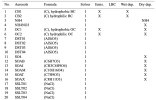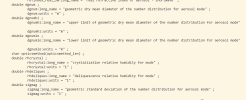-
The www2.cesm.ucar.edu website is currently down for maintenance
You are using an out of date browser. It may not display this or other websites correctly.
You should upgrade or use an alternative browser.
You should upgrade or use an alternative browser.
PM2.5 as output in cam6
- Thread starter anushree
- Start date
Hi @Hemraj ,
PM2.5 is a direct output in cam6 if you are using the chemistry version i.e FCHIST. CESM2.a.b (where a and b are version numbers) is giving PM2.5 as direct output which was not the case in CESM1.2.2.My question was actually regarding CESM2.2 with FCHIST compset for which i have not found the answer yet.I will let you know if i get one.
Thank you.
PM2.5 is a direct output in cam6 if you are using the chemistry version i.e FCHIST. CESM2.a.b (where a and b are version numbers) is giving PM2.5 as direct output which was not the case in CESM1.2.2.My question was actually regarding CESM2.2 with FCHIST compset for which i have not found the answer yet.I will let you know if i get one.
Thank you.
Dear @anushree,
I am using CAM4 just because I am interested in surface chemistry and I hope this saves the computational cost. I can't see the PM2.5 as model output and I have to manually calculate it on my own (maybe the addition of some aerosol species, but not sure which species).
I can see PM2.5 mentioned in code as @fgl said, but what are we going to do with this line...I am not clear. The base thing is there is no model output for PM2.5 and I have to calculate it myself. The question is how to get it now? I have seen some papers (https://acp.copernicus.org/articles/15/2805/2015/acp-15-2805-2015.html) that add some of the chemical species (NH4NO3, OC*2, BC, SO4, DST, and SSLT) to get PM2.5. Can I do the same? But I wonder if we count NH4NO3, how about NH4SO4 (no model output)? Instead how about we separately add NH4 and NO3 together with other species. Of course, this will not be total PM2.5 but hopefully may represent the total PM2.5 (maybe 90%, not sure).
Thank you.
I am using CAM4 just because I am interested in surface chemistry and I hope this saves the computational cost. I can't see the PM2.5 as model output and I have to manually calculate it on my own (maybe the addition of some aerosol species, but not sure which species).
I can see PM2.5 mentioned in code as @fgl said, but what are we going to do with this line...I am not clear. The base thing is there is no model output for PM2.5 and I have to calculate it myself. The question is how to get it now? I have seen some papers (https://acp.copernicus.org/articles/15/2805/2015/acp-15-2805-2015.html) that add some of the chemical species (NH4NO3, OC*2, BC, SO4, DST, and SSLT) to get PM2.5. Can I do the same? But I wonder if we count NH4NO3, how about NH4SO4 (no model output)? Instead how about we separately add NH4 and NO3 together with other species. Of course, this will not be total PM2.5 but hopefully may represent the total PM2.5 (maybe 90%, not sure).
Thank you.
CAM4 does not have the same level of comprehensive chemistry and many updates are made with CAM6, especially for updated modal scheme of aerosols and the SOA species to get a better representation of the aerosol species. If you post a copy of you atm_in (<case_directory./CaseDocs/atm_in) file I can try to point your towards the species that you will need to use for offline calculations. The aerosol species will end in a "_a1-4" suffix labeling what modal size bin they are in. Here is an example from a freshly built CESM2.2 CAM6 run:Dear @anushree,
I am using CAM4 just because I am interested in surface chemistry and I hope this saves the computational cost. I can't see the PM2.5 as model output and I have to manually calculate it on my own (maybe the addition of some aerosol species, but not sure which species).
I can see PM2.5 mentioned in code as @fgl said, but what are we going to do with this line...I am not clear. The base thing is there is no model output for PM2.5 and I have to calculate it myself. The question is how to get it now? I have seen some papers (ACP - How emissions, climate, and land use change will impact mid-century air quality over the United States: a focus on effects at national parks) that add some of the chemical species (NH4NO3, OC*2, BC, SO4, DST, and SSLT) to get PM2.5. Can I do the same? But I wonder if we count NH4NO3, how about NH4SO4 (no model output)? Instead how about we separately add NH4 and NO3 together with other species. Of course, this will not be total PM2.5 but hopefully may represent the total PM2.5 (maybe 90%, not sure).
Thank you.
'bc_a1', 'bc_a4', 'dst_a1', 'dst_a2', 'dst_a3', 'ncl_a1', 'ncl_a1', 'ncl_a2', 'ncl_a3', 'pom_a1', 'pom_a4', 'so4_a1', 'so4_a2', 'so4_a3', 'soa1_a1', 'soa2_a1', 'soa3_a1', 'soa4_a1','soa5_a1', 'soa1_a2', 'soa2_a2', 'soa3_a2', 'soa4_a2', 'soa5_a2'
Ok so using CAM4 you are using the bulk aerosol scheme, not the modal aerosol scheme that is implemented in CAM5 and CAM6, hence the missing modal aerosol tracers. I am not as familiar with that mechanism, but following the details in Tilmes, et al. (2016, GMD) your species are:

I cannot recommend a method for deriving PM2.5 from the bulk aerosol scheme, but according to the CESM1.2 Manual, you should have files that describe the physical properties of each tracer within the code. It might be worth looking to see if that has assumed size distribution or a mean size parameter, which you can then use to estimate PM2.5. That being said, I stand by my previous comment that the newer version of CESM and CAM6 have many improvements in the representation of aerosols and specifically health-relevant PM2.5.

I cannot recommend a method for deriving PM2.5 from the bulk aerosol scheme, but according to the CESM1.2 Manual, you should have files that describe the physical properties of each tracer within the code. It might be worth looking to see if that has assumed size distribution or a mean size parameter, which you can then use to estimate PM2.5. That being said, I stand by my previous comment that the newer version of CESM and CAM6 have many improvements in the representation of aerosols and specifically health-relevant PM2.5.
The names used to identify the bulk aerosol species are hardcoded in the build-namelist utility and are specified to the prescribed_aero module by the namelist variable prescribed_aero_specifier as follows:
prescribed_aero_specifier =
'sulf:SO4', 'bcar1:CB1', 'bcar2:CB2', 'ocar1:OC1', 'ocar2:OC2',
'sslt1:SSLT01', 'sslt2:SSLT02', 'sslt3:SSLT03', 'sslt4:SSLT04',
'dust1:DST01', 'dust2:DST02', 'dust3:DST03', 'dust4:DST04'
The first name in each of these colon separated pairs is the one the prescribed_aero module adds to the physics buffer, while the second name is the variable name in the dataset. The first names for all the species except the sea salt bins (sslt1, ..., sslt4) are the ones that appear in the rad_climate specifier. Sea salt is treated specially by repartitioning the total mass in the four bins into a coarse and an accumulation mode with the names SSLTC and SSLTA respectively. The repartitioning is done by the sslt_rebin module.
Each of the aerosol species has an associated file which contains physical and optical properties.
Hi, @fgl,Ok so using CAM4 you are using the bulk aerosol scheme, not the modal aerosol scheme that is implemented in CAM5 and CAM6, hence the missing modal aerosol tracers. I am not as familiar with that mechanism, but following the details in Tilmes, et al. (2016, GMD) your species are:
View attachment 2034
I cannot recommend a method for deriving PM2.5 from the bulk aerosol scheme, but according to the CESM1.2 Manual, you should have files that describe the physical properties of each tracer within the code. It might be worth looking to see if that has assumed size distribution or a mean size parameter, which you can then use to estimate PM2.5. That being said, I stand by my previous comment that the newer version of CESM and CAM6 have many improvements in the representation of aerosols and specifically health-relevant PM2.5.
I used the modal aerosol scheme (MAM3) in CAM5, and I think we can use the total mass in the Aitken and Accumulation modes and a part from the Coarse mode the to represent the PM2.5. But the point is how to get the PM2.5 fraction in coarse mode. According to the inputdata file of MAM3 (atm/cam/physprops/mam3_mode3_rrtmg_c110318.nc; also be attached), the geometric standard deviation, the geometric mean diamater and the size range seem to be prescribed and constant. If so, the lognormal distribution of aerosol is prescribed and does not vary with time and location. Then the PM2.5 fraction of coarse mode will be constant. However, the aerosol size changes over time, which is the deliquescence process. I wonder if MAM3 sets the aerosol log-normal distribution as a constant for a particular mode, and if not, how to get the PM2.5 fraction for the coarse mode? Many thanks! I've been puzzled by this question for a long time.
It seems that I can not upload the NC file here. So I show the relative variables in the following picture:Hi, @fgl,
I used the modal aerosol scheme (MAM3) in CAM5, and I think we can use the total mass in the Aitken and Accumulation modes and a part from the Coarse mode the to represent the PM2.5. But the point is how to get the PM2.5 fraction in coarse mode. According to the inputdata file of MAM3 (atm/cam/physprops/mam3_mode3_rrtmg_c110318.nc; also be attached), the geometric standard deviation, the geometric mean diamater and the size range seem to be prescribed and constant. If so, the lognormal distribution of aerosol is prescribed and does not vary with time and location. Then the PM2.5 fraction of coarse mode will be constant. However, the aerosol size changes over time, which is the deliquescence process. I wonder if MAM3 sets the aerosol log-normal distribution as a constant for a particular mode, and if not, how to get the PM2.5 fraction for the coarse mode? Many thanks! I've been puzzled by this question for a long time.

